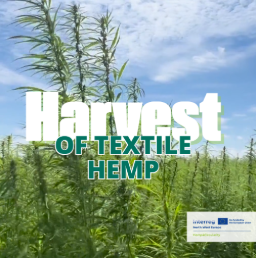Valbiom held its third and final summer session of growers’ training in Wallonia on August 4th, spotlighting a hands-on hemp variety trial and an exciting harvesting demonstration — all within the Hemp4Circularity project. Let’s take a look back—both in text and video!
Demonstration of the Sativa 200
The event featured a demonstration of the brand new Sativa 200, fresh from Hyler’s workshop, along with presentations on the local hemp value chain and the current advancements in long-fibre hemp.
More than 25 participants—including key stakeholders from across the value chain such as growers, scutchers, machine manufacturers, agricultural unions, research centres, and contractors—gathered in the field to witness the remarkable performance of the Sativa 200, which achieved a harvesting rate of 2 hectares per hour on Valbiom’s trial.
Variety trial and key agronomic data
The trial consisted in comparing 4 hemp varieties (USO31, SAN27, MUKA, Bialobrzeskie) in 2 repetitions. The 4 varieties did not show big differences. The canopy hight was about 2 meters. The plant density ranged from 247 to 295 per square meter, which is precisely the density expected for long fibre hemp.
With about 12 to 14 tons of dry matter par hectare, Valbiom expects to have about 5 tons of straw per hectare. The baling and scutching will give presumably more insight into the differences between varieties.
Hemp4Circularity: building a circular textile hemp value chain through collaboration
This demonstration was part of the growers’ training. Earlier in the day, it also served as a pre-session for the ‘Ambassadors of Hemp for Textile’ training, which focuses on raising knowledge and awareness about hemp textiles among growers and key stakeholders.
Hemp4Circularity aims to establish a circular value chain for hemp as a high-value textile material by 2027. Rooted in the North-West Europe flax processing industry, the project integrates actors from local agriculture, primary processing (similar to flax), downstream processing, and mechanical fibre recycling. It also seeks to raise awareness among designers and consumers about hemp textiles.
The training sessions and live demonstrations like this one foster collaboration, knowledge exchange, and networking—key factors for developing a sustainable hemp textile sector.
↓ CHECK THE VIDEO ↓
